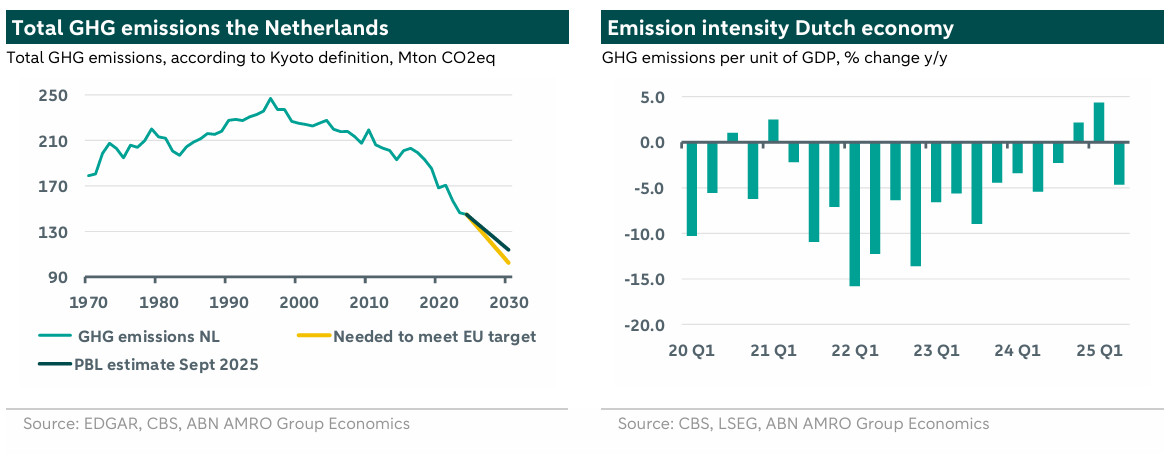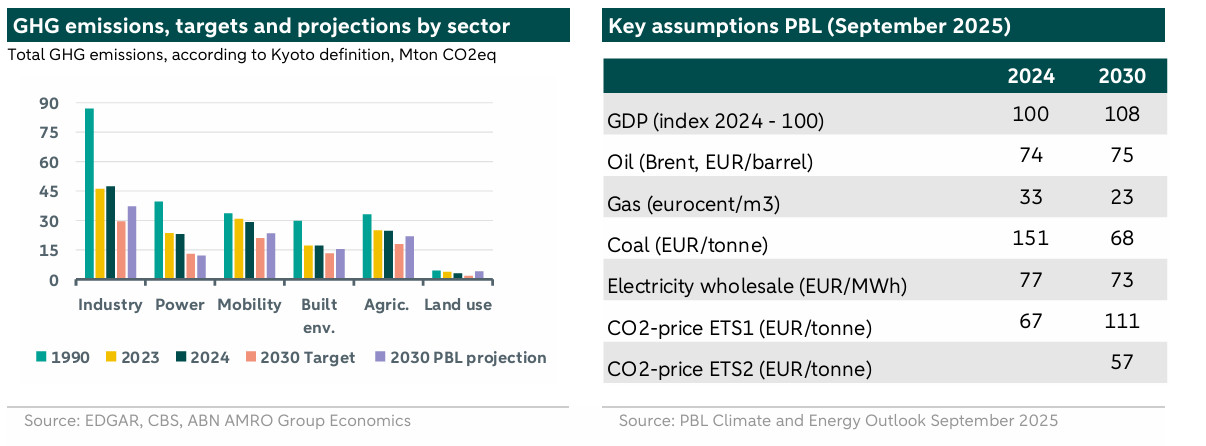ESG Economist - The Netherlands’ GHG reduction slows down

General elections in the Netherlands are scheduled for 29 October, offering a good moment to review the outgoing government’s climate policies and the latest developments in greenhouse gas (GHG) emissions and other climate-related variables.
In 2024, the pace of GHG emission reductions slowed, the emission intensity of the Dutch economy stagnated, and long-term projections for renewable energy use declined.
The September 2025 report by PBL Netherlands Environmental Assessment Agency concludes that “reaching the 2030 climate goal is extremely unlikely” and highlights the urgent need for “additional and structural policy”.
This increases the risk of a disorderly, shock-driven transition, as the Netherlands remains obligated to meet the EU’s 2030 climate targets.
Introduction
General elections are scheduled to take place in the Netherlands on 29 October 2025. The outgoing government, which assumed office in July 2024, collapsed within a year, entering caretaker status in early June 2025. Given the short tenure of the government, only a limited number of climate policy measures was introduced. Meanwhile, the annual reduction in greenhouse gas (GHG) emissions has slowed to its lowest pace (excluding the pandemic years) since the adoption of the Paris Agreement. According to the independent PBL Netherlands Environment Assessment Agency (PBL) there is a need for additional and structural climate policy measures in order to meet the EU targets for GHG emissions, renewable energy use and total energy use. In this note we assess the recent changes in GHG emissions, energy consumption and the usage of energy from renewable sources, and the probability that the EU targets for these variables will be met. In a follow-up note we will evaluate the climate policy plans of the biggest political parties that have a high probability of being in the next coalition government, and the likelihood that the necessary step-up in climate policy will take place in the coming years.
Pace of reduction in GHG emissions has slowed down and meeting the EU targets is ‘extremely unlikely’
Total GHG emissions fell by 1.1% yoy in 2024, which followed upon declines by almost 7% and 8% in 2023 and 2022, respectively. The annual reduction in emissions in 2024 was the lowest (excluding the pandemic years) since the Paris Agreement. Emissions by the climate sector industry increased in 2024 (+3%). According to the “Climate and Energy Outlook for the Netherlands KEV 2025” by PBL () this was due to an increased use of coal and because Tata Steel became fully operational again after major maintenance in 2023. GHG emissions by the mobility sector declined noticeably (-5%), which was related to a lower use of diesel after a hike in the excise duty on diesel in 2023, more use of biofuels and an increased use of electrical vehicles (the share of electric passenger cars in the total number of passenger cars increased to 5.5% in 2024, up from 5% in 2023). Next, GHG emissions by the power sector declined moderately (-2%) due to more use of power from renewable sources (i.e. sun and wind), while GHG emissions by the sectors agriculture and the built environment roughly stabilised in 2024.
The decline in emission reductions was not addressed by policy measures of the outgoing Schoof cabinet. On the contrary, in the Spring Memorandum 2025, the government decided to issue more dispensation rights for the manufacturing sector until 2032, thereby applying the CO2 tax to a smaller portion of industrial emissions. In addition, in July 2025, it decided to suspend the CO2 tax for industry companies under EU ETS until 2030. More general climate measures by the outgoing government are a reduction in the 2040 targets for offshore wind energy (from 50 gigawatt to 30-40 gigawatt in 2040) and a reduction of the available budget for climate subsidies (from EUR 3.3bn per year to 2.3bn per year). Additionally, tailor-made agreements between the government and large companies to reduce emissions are being established only slowly and a number of the discussions regarding these tailor-made agreements have been discontinued.
According to the PBL the probability of the Netherlands meeting the 55% reduction target in 2030 versus 1990 (based on current implemented policy ‘proposed and adopted’) is less than 5% (see the table below). The PBL’s estimates for the level of GHG emissions in 2030 are somewhat lower than a year ago (2-3 megatons), but the PBL mentions that this is not due to policy changes but to changes in external factors, changes in methodology and lower estimates for the level of production in industry.

Regarding a specific part of total GHG emissions, methane, the probability of meeting the target is also less than 5% according to the PBL, which is the same probability as for total GHG emissions. The Netherlands has joined the Global Methane Pledge, implying that it needs to reduce its methane emissions (of which 74% came from agriculture and 19% from the manufacturing sector in 2024) by 30% in 2030, compared to 2020. In 2024, methane emissions were less than 8% below the 2020 level and the PBL estimates that the reduction will be around 19.5% by 2030. The outgoing government had planned to aim for a reversal of the phase-out of the derogation under the EU Nitrates Directive and to obtain a new derogation. This would result in less methane emission reduction (16.5% instead of the 19.5% mentioned above) as a new derogation would requiring less reduction in the dairy cattle population. However, these plans have not been included in the PBL projections as they have not become effective.

Better news comes from ESR emissions, another component of total GHG emissions. Emissions under the EU’s Effort Sharing Regulation (ESR), which are emissions excluding those covered by ETS1 and excluding emissions related to Land Use, Land-Use Change, and Forestry (LULUCF). The target for the Netherlands is based on a 48% emission reduction in 2030 compared to 2005, which would roughly be equal to a 49% reduction compared to 1990. This EU target provides a cumulative emission budget of 830 megaton for the period 2021-2030 for the sectors of built environment, mobility, agriculture and non-energy intensive industry. In the PBL projections, the Netherlands remains well below this ceiling with 781-816 megatons. The PBL states that there is a higher than 95% probability of the Netherlands meeting the specific ESR target.
The quarterly emission intensity of the Dutch economy (total GHG emissions per unit of GDP) declined non-stop (y/y) between 2021Q2 and 2024Q3 but subsequently increased during 2024Q4-2025Q1. In 2025-Q2 it fell again, albeit at a slower pace than the year before. All in all, the pace of the decline in GHG emission reduction clearly slowed down in 2024 and the reduction in the emission intensity of the Dutch economy has stagnated.
Probability of meeting the EU targets for renewable and total energy usage also low
The Netherlands also needs to meet the EU-targets regarding total energy usage and the share of renewable energy in overall energy consumption. The 2030 target for final energy consumption (consumption by end users, e.g. households and industrial companies) is set at maximum 1,609 petajoules (see table above). During the years 2022-2024 final energy consumption in the Netherlands declined significantly, but in 2024 it increased slightly, which was due to more consumption by greenhouse horticulture and international aviation. According to the PBL, the probability that the Netherlands will meet the EU target is about 10%. The PBL’s estimates for final energy consumption have declined slightly compared to its estimates of a year ago, which is due to lower energy consumption by industry on the back of lower production output, although this is partly offset by higher energy consumption by datacenters.
Next, primary energy consumption in the Netherlands (final consumption plus use by the energy sector) roughly stabilized in 2024, compared to 2023, as the rise in final energy use was offset by a decline in conversion losses in the electricity sector. The PBL projects that the probability of the Netherlands meeting the EU target of a maximum usage of 1,935 in 2030 is lower than 5% (see table above).
Finally, the share of renewable energy in total gross final energy consumption increased to 20% in 2024, up from 17% in 2023. The rise was the result of more windmills at sea and a doubling of the use of biofuels in road transport. Although the PBL projects that the share of renewable energy will continue to rise in the coming years, the pace will be too low the reach the EU’s 39% target. In fact, the PBL also sees a lower than 5% probability that the Netherlands will meet the EU target for this climate variable. The PBL’s estimates for the share of renewable energy in 2030 are one percentage point lower than a year ago, which is mainly due to delays in the construction in offshore wind farms, more curtailment in large-scale sun energy projects and a delayed adoption of geothermal energy in horticulture.

Conclusion
The reduction in GHG emissions has slowed down in 2024, while final energy consumption increased, primary energy consumption stabilised and the emission intensity of Dutch GDP stagnated. Moreover, the longer-term projections for the share of renewable energy in total energy use have declined somewhat. Following the general elections of 29 October, the next Dutch coalition government will have to significantly step-up climate policy measures if it still wants to meet the EU climate targets in 2030. In case it fails to do so, the likelihood of a disorderly and shock-driven transition at a later stage rises, as the Netherlands remains obligated to meet the EU’s climate targets in 2030. In a follow-up note we will evaluate the climate policy plans of the biggest political parties, that have a high probability of being in the next coalition government, and we will assess the likelihood that the necessary step-up in climate policy will take place in the coming years.
